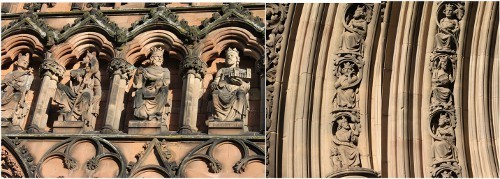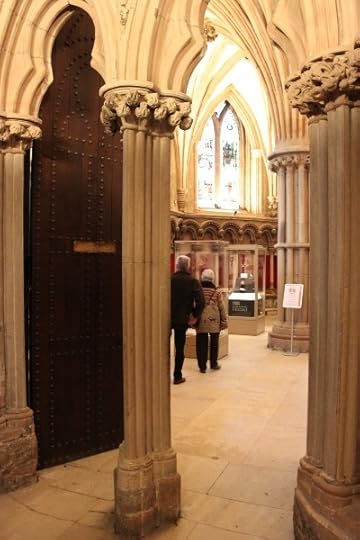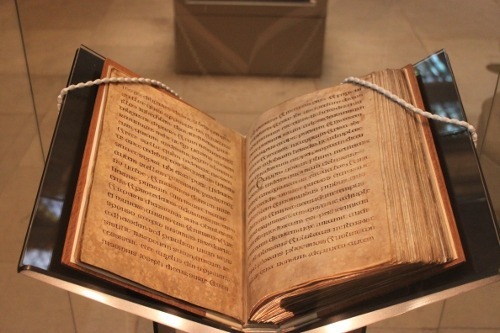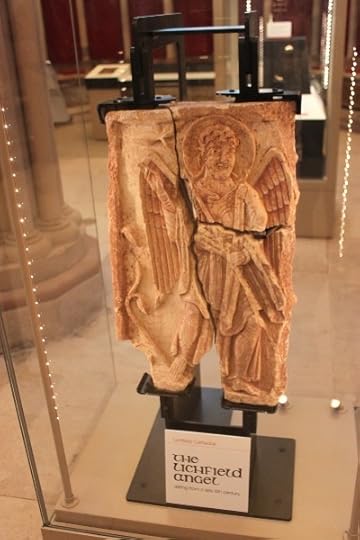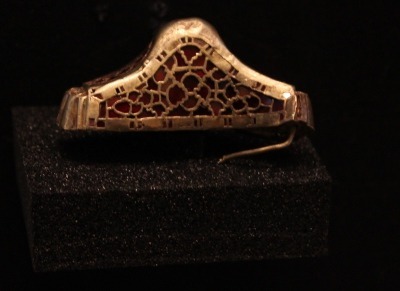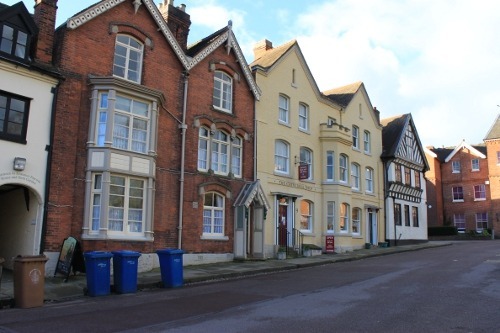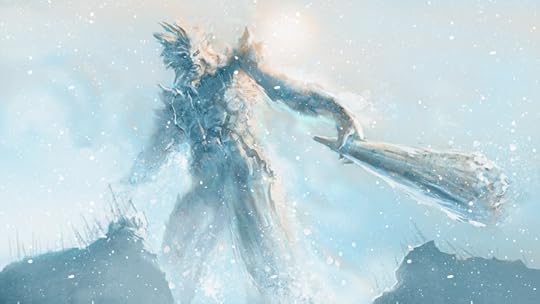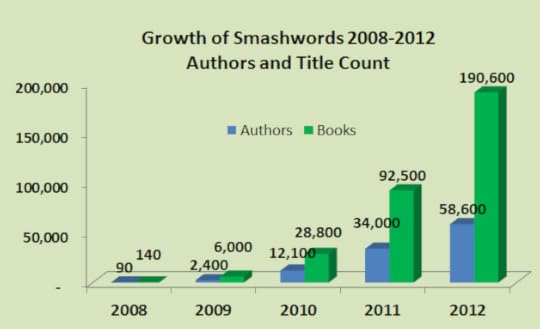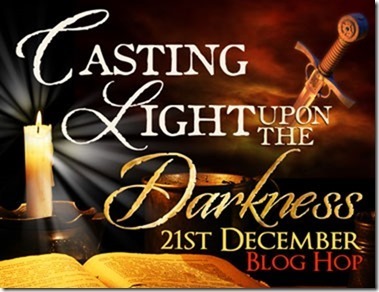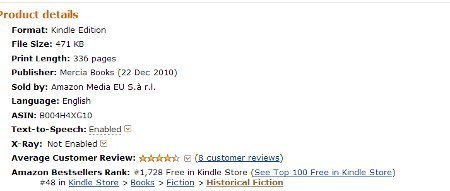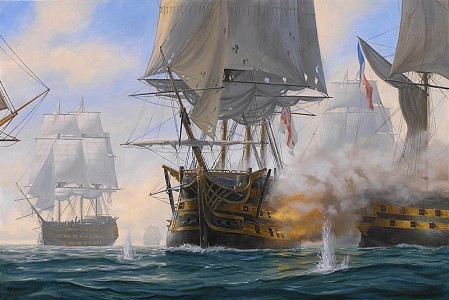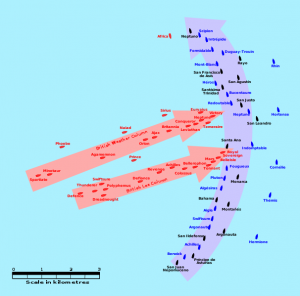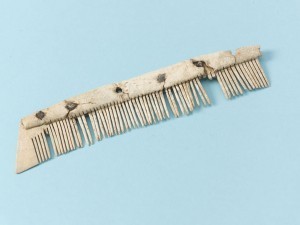Richard Denning's Blog, page 5
January 11, 2014
Anglo Saxons Treasures at Lichfield Cathedral
One of the perhaps lesser known cathedrals in England is the one at Lichfield. Nowadays Lichfield is an attractive but small city dwarfed by the near by West Midlands conurbation of Birmingham-Coventry-Wolverhampton-Black Country. Yet in the early to mid Saxon period it was one of the more important cities. Indeed it was the see of the Bishop of Mercia which at one time was a powerful kingdom that stretched from Wales to the North Sea. At the peak of its power under the 8th century King Offa, Lichfield was even briefly the seat of an Arch Bishop. Offa was so powerful that he was able to persuade the Pope to create an Archbishopric in Lichfield who would hold sway over the midlands. On Offa’s death the position was annulled but Lichfield maintained its position as an important Cathedral for many centuries.
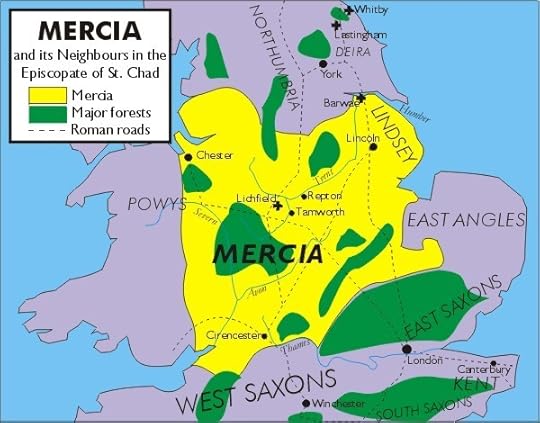
The Cathedral is dedicated to St Chad and St Mary. Although there had been missionary work going on in Mercia previously the kings of Mercia had been pagan. In 669 one of the first christian kings of Mercia, Wulfere, requested a bishop and Chad was sent to take up the post. He established his see at Lichfield possibly because land had been donated for the establishment of a monastery there and it was close to the Mercian capital at Tamworth.
The modern structure is the third Cathedral to stand on this site. The first – Saxon – building was built around AD 700 and was built of wood. It survived almost 4 centuries before – in 1085 – it replaced by a Norman cathedral made from stone. That second structure did not last that long being in turn replaced by the present cathedral from 1195 onwards.
The front (west side) of the cathedral has a magnificent collection of statues that themselves are worthy of note. This facing was renovated in Victorian times and portrays an amazing array of Kings and Queens. These include the Norman and subsequent monarchs right across the front. What I love about this building is the Saxon era is not ignored. The archways over the side doors (not the central one) contain statues of the important kings of first Northumbria (who held sway over much of Mercia) and later Mercia. So we can see little effigies of Aethelfrith Edwin, Oswald, Oswy Penda,Wulfere and others. We also have statues of the churchmen who had an impact on the early and later Saxon Era – Pope Gregory, Augustine, Paulinius, Chad and so on.
The octagonal shaped Chapter House, which was completed in 1249 is possibly the most beautiful part of the Cathedral. It houses a permanent exhibition of the cathedral’s greatest treasures: the Lichfield Gospels, parts of the Staffordshire horde and the Lichfield Angel.
The Lichfield or St Chad’s Gospels.
The Lichfield Gospel or bible is one of the oldest in Britain. It was created in the early 8th century and perhaps dates to around 730 – slightly younger than the Lindisfarne Gospels with which it share similarities in style. It consists of the gospels of Mathew and Mark and the start of Luke. It used to also contain the rest of Luke and John but at some stage in the 17th century that part was lost. This was probably during the Civil War period. It is still used in services twice a year – making it the oldest bible used in services in the UK. On the day I visited it was open to the story of the wise men. I can’t read Latin but the curator pointed out to me the verse speaking of the gifts. The clarity of the letters is extraordinary. The Gospels also contain marginal notes in Old Welsh. These notes represent the oldest surviving Welsh Words anywhere. It is believed the bible was actually made in Wales and came to Lichfield early in its life.
The Lichfield Angel
In February 2003 work was being done on the nave of the Cathedral. As the builders worked they came across an eighth century sculpted panel of the Archangel Gabriel. It was thought to be part of a stone chest, which contained the relics of St Chad. Red pigment found on the angel was dated to the 8th century. It is now exhibited in the cathedral.
The Staffordshire Horde
Hammerwhich in Staffordshire, where the Staffordshire Horde was found, is just a few miles from Lichfield. There in 2009 the greatest collection of metal and gold artifacts from the 7th or 8th centuries was found. Over 3500 objects comprise the findings – some of remarkable quality. The Horde is houses in a number of locations. A small amount is kept at Lichfield.
I can recommend a visit to Lichfield Cathedral . The actual building is surrounded by a very attractive Cathedral Close which house several Tea shops. It is only yards from the small but pleasant city centre which also hosts the DR John-stone Birthplace Museum and the Erasmus Darwin museum.
January 8, 2014
D.I.Y Book Publishing
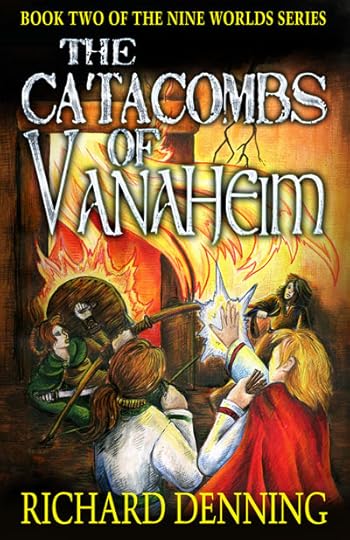
The cover for my new book The Catacombs of Vanaheim
On Wednesday 8th January I signed off the proof of my latest book ‘The Catacombs of Vanaheim.’ All books have their own story and route to publication and every author will have their own approach. I thought it might be of interest to talk about how The Catacombs of Vanaheim got into print. Catacombs is actually the second in the Nine Worlds Series. The Nine Worlds series is a Historical Fantasy Adventure For Children of Ages 9+ in which the historical world of Anglo-Saxon England meets the mysterious world of myths and legends, gods and monsters our ancestors believed in. This is the world as it might have been had those stories been true…
I dreamed up the idea for the series in late 2011 and wrote the first novel Shield Maiden over the winter. It was published in Spring 2012. It received some good reviews and won a prize in the USA. In 2013 I started writing a sequel.
Starting with a snow flake. I tend to use an approach to plotting a novel called the snow flake technique. You start with the basic concept of the novel – the essential question that needs to be answered. Then you expand this to a simple outline of the essence of the book -usually a paragraph that discusses the main character, what he/she wants and what prevents them from getting it. That paragraph can even become the back page blurb as it did in Catacombs:
The Bifrost – the passageway between the Nine Worlds – is open and now Anna’s village is under attack by creatures and horrors the villagers are not prepared to deal with. So now Anna and her companions must travel to Vanaheim, home to the Vanir: gods of wisdom and magic. There the young sorcerer, Wilburh, hopes to obtain a way to protect their village. It is not as easy as all that for Wilburh’s magic is failing him and they find that the gods themselves are prisoners. To free them the children must enter the deadly Catacombs. In there they will need all their courage and skills just to survive.
Expanding the Outline. From that paragraph I now expand the plot in stages, writing a 3 or 4 paragraph summary in which each paragraph is an ‘act’ in the Novel usually ending in some disaster or problem that only worsens their predicament. From that outline I try and pull out a sentence that will become each chapter and finally we have a plot chapter by chapter.
Its all about Characters. Books need characters. They should not just be about plot. Its not just about what happens but to whom stuff happens. In particular we need to get a idea and write notes on how characters change especially the main character. Each book should ideally involve a character altering or changing in some way. Characters need aims and motives – what do they want and why. They should have some weakness ideally or at least an obstacle preventing them getting what they want.
Writing the book. Finally after some months of plotting I begin writing the book. Now I work full time, run a large hobby convention annually and have 2 kids. So getting words on the page can be hard at times. There is no clever solution beyond this simple advice: Each day sit down and write a paragraph. Just a paragraph. If you cant manage more than that just do that. Often a paragraph becomes two or three, a page or a chapter but even if it does not you have 30 more words on your page.
“The first draft of anything is shit.” Ernest Hemingway
Drafts. Hemingway had a point. The first draft will be rubbish. To me though the hardest thing is getting 30,000 to 50,000 words down. Once you have done that, once you have a book of sorts then the next phase is what creates the novel from that mass of words. The first draft is for me alone. No one else sees that. I now spend a good few weeks redrafting it twice through. In this process I am looking for the overall continuity. I am looking for major holes and story threads that go no where that need tidying up. I am checking if a characters story is developed. I then pass the draft to my first readers – family members. What I want from them is not editing (although if they spot spelling and grammar errors I welcome that) – what I want is an opinion on does the story make sense? Does it go anywhere? Again are there holes and problems? I then redraft again and again. By now we are around 9 months into the writing of Catacombs.
Sharpen your pencil Gill. At this stage – or actually even earlier when I had an early draft, I asked Gill Pearce of Helion’s Art to start coming up with the images. I identified around 20 scenes I wanted ink drawings of, a map and a front cover. Gill starts getting busy with ideas. Gill has had her share of illness this year so she performed wonders completing the images.
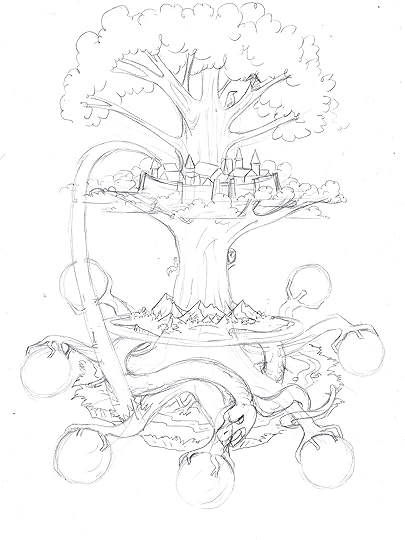
An early sketch for the Nine World Map
Editing Once I have the draft at a satisfactory point I send it to my editor Jo Field . Jo and I fling versions of the chapters back and forth, arguing about turns of phrase and so forth. Of course spelling is corrected and grammar errors fixed but editing is much more than that. Jo spots continuity errors, makes suggestions for alternatives in certain scenes and generally improves the book. the editing often takes a couple of months or more.
Book cover. Around the time I send the book for editing I usually engage the services of Cathy Helms of Avalon Graphics. Its Cathy that creates the book cover. In the case of Catacombs that mean taking an image Gill had drawn and painted and using that to make the book cover. We encountered a slight problem here. I had given the go ahead for Gill to paint the cover before Cathy had fed back that she needed a wider image. Poor gill had to stick card to the image and paint a wider area which she did brilliantly. I learned a lesson there to check with the book cover graphics designer that the artwork fits!
Lay it all out man! When all is ready I start laying out the book in Indesign (not word which is poor at layout for books). Much time is spent ensuring the look of the book is correct margin sizes, style of chapter headings etc. Then I drop the text in and in the magical way that Indeisgn works the text flows through the book. I drop in the images and tidy it all up and export to pdf.

uploading the book
Signing of on the proof. Once the text of the book and the separate cover pdf (from Cathy) is uploaded I wait anxiously for the message that the files are approved. I then get to see a digital proof of the book. Hopefully there are few or no amendments needed and bingo the book is made ready to print! It will take 2 or 3 weeks to show up on Amazon etc as on sale but the same day I order a box load of books and send Cathy, Jo and Gil their own copies.
E-books. Of course it does not end there. The book needs e book conversion to not only 1 but three main distributors – Amazon Kindle, Smashwords for Apple, Kobo, Barnes and Noble, Sony etc and finally Google E-books.
The whole process took around a year for the 40,000 word novel.
I hope that insight is of interest. Now to get on and write another novel!
January 6, 2014
The Creation of the World in the Norse Myths
Well its the first Monday of January so I thought I would start a series of articles I am calling Monday Myths. To begin with I am looking mainly at the Norse-Germanic Myths of Northern Europe. Since its a beginning lets start WITH a beginning.

According the legends of the Norse, Germanic Tribes and Anglo-Saxons in the beginning there were no stars, moon or earth. There was a vast icy waste called Niflheim and a land of fires called Muspelheim. Between the two was a deep void, a pit called Ginungagap. Gradually as the fire rages the ice melted and in that steam and water life sparked. It took the form of a huge Frost giant called Ymir and a ice cow. The giant drank the cows milk and the cow licked salty water from the edge of Ginungagap.
From between the toes and under the armpits of Ymir creatures emerged. These were the race of giants. Meanwhile the cow was busy licking away at the salty ice and uncovered a woman. The woman and Ymir had three children – the oldest of the Gods Odin, Vili and Ve (alternatively called Hoenir and Lodur). As often happens in these legends the children rose up and killed the father. Out of Ymir’s body the universe was created – from chest grew the great World tree Yggdrasil, his skull became the vault of the skies, his bones mountains and his blood the seas. His hair became trees, his brains became the clouds and his eye brows, Midgard or Earth.
With his blood filling the Ginungagap the race of giants – the Jotun fled to setup their own world and were for ever enemies of the Aesir gods whom Odin was the leader.
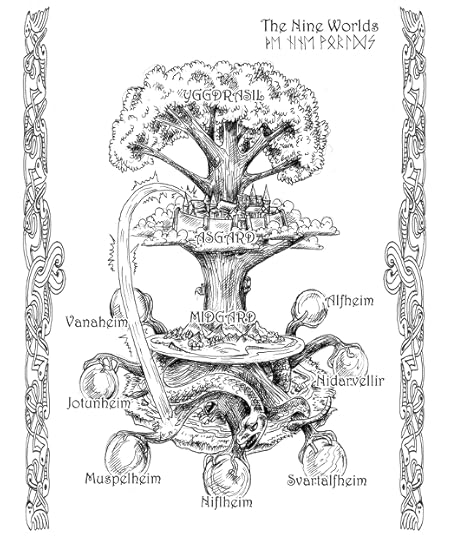
The Nine Wolrds of the Universe in the World Tree.
The above map is by Gillian Pearce for my new book The Catacombs of Vanaheim.
January 1, 2014
Self Publishing in 2014
So we begin 2014. I have been self publishing my own novels for 4 years now. When I started out the whole world of e-book self publishing and Indie Publishing of paperbacks had not long begun to enter the phase we find ourselves in. Kindle came to the UK at the end of 2010. Smashwords had been around a year or two longer whilst Google e-books have only really taken off in the last 2 years. At the same time sales of Kindle and other e-book readers became significant and sales of e-books competed with paperbacks.
It was this growth of uptake of e-books that really opened the door for self published writers to gain readers nationally and internationally. No longer were they restricted to trying to get shelf space in bookshops where they stood little chance of competing with big name authors and large publishers. If their books were good they could get noticed and read by a large audience. It was this revolution that has created a number of e-book millionaires. For the rest of us (non millionaires) what it means is we could continue to gain readers and sell books without being reliant on the small numbers of sales that a typical book fair brings. So much for history – what will 2014 bring for self publishers?
The Year ahead
The growth in the number of self published authors and titles has been extraordinary. The graph above just applies to the growth of Smashwords (the US based e-book distributor). I got in on Smashwords early in 2010. At that point there were 2500 or so authors distributing e-books this way. There are now approaching 60,000. That is in addition to those who don’t use Smashwords and only use Kindle or Google Ebooks. So some hundreds of thousands of self published authors are pouring out their work.
Now the problem here is two fold. Firstly the quality of the writing of all these authors varies. Some books are great and some very poor. There is no control on self publishing – anyone can do it. (I have spoke elsewhere about the need for authors to have editors and to learn about book lay out and book design and use a cover artist). So there is a lot of rubbish out there. Good stuff too of course but a lot that needs work.
The second draw back is that of market forces. There are only a certain number of books going to be bought world wide. Yes e-book sales are growing but there will be a point when the sales cannot sustain the authors expectations.
What then occurs? Well it depends on what authors aim to get out of their writing. If they just enjoy the writing, have some readers, make some sales but don’t care about the numbers and don’t rely on the money then these authors may carry on.
Others may have launched into the endeavor full of dreams of making their first million in a year. Whilst the likes of Amanda Hocking, Joe Konrath and others show that it is possible to make it big time the reality is that most self published titles sell something like 50 to 200 copies ever (mostly to friends and family).
So there is a now a glut of authors pushing out work. There is a lot of good work there and indeed recently I saw an article that said that 25% of the top 100 Kindle e-books were self published. The trick is getting your own work noticed. If they are not noticed and an author does not make sales a disillusionment will set in – no doubt leading to many giving up.
There is much talk of the slow burn in regard to book sales. I can personally see this happening. Sales of the first book in a series lead to the 2nd and 3rd. Sales grow steadily but not (unless you are lucky) suddenly. When I see that happen, or when I get an email or social media contact asking about sequels) it encourages me to get the next book out. More than this, if readers enjoy a series and I know they do, then I enjoy writing more and that then produces better books – I hope.
Each year brings new developments. More markets open up as e-books go on sale in new countries. This last month I sold my first books in India as well as Germany, France and Brazil.
So 2014 will be a year of challenge for self published authors. Can they build and maintain readership or will they find the competition, the struggle to get attention and readership simply too hard.
How about me? Well check back with me in a year and I will let you know.
Here are my Top 10 Tips for Self Publishing
Here are my tips on getting started self publishing.
1. Keep writing and re writing. It takes years to develop as a writer. I am still early in this process myself and I have been writing for 15 years.
2. Consider joining writers groups or organisations likeNew Writers UK
3. Research your options extensively. It is worth attending events like the Self Publishing Conference in March, London Book Fair in April , NAWG writers festivalin August, The Historical Novel Society Conference in September and already mentioned NWUK Anual Fair in October. These all have talks on the process of self publishing and/ or are good points to make contacts.
4.Decide whether you have the technical skills to layout books yourself. Can you convert to e-books? Can you learn.?If you can then you can save a lot of money but if you can’t then use companies but be cautious and ask around a lot. Those contacts from 2 and 3 can help here.
5. Employ an editor. No really you need one. You cant edit your own work and don’t rely on your aunt. Yes relatives and friends can be helpful as first readers to give early feedback but you need to pay someone who will tell you what does not work and what does.
6. You probably need a cover artist as well. Some authors can do this themselves but most cant.
7. Release the book.. Get reviews (don’t pay for them – give the book away but don’t pay for a review). Blog about it, tweet and flash it about the social media but in moderation. No one likes “Buy my book” messages in their face. Find other ways to promote the content. Like doing talks about Life in AD 600 as I do.
8. Don’t put all your eggs in one basket. Publish a paperback as well as an e-book. Schools still like physical books as do libraries. Having a physical book to show at book fair beats a flyer. But also get into e-books. You cannot hope to compete if in paperback only. Get it on Kindle but also Smashwords and Google e-books. Some books sell better in one location than others. Broaden your reach.
9. Write the next book and the next. Readers like to know that if they commit to a new author there is a future here. We all do this – I read every Pratchett and Cornwell book as a matter of course.
10, Be helpful to others Review other peoples books. Tweet and comment about other authors. Share their blogs. Answer author’s questions. Build relationships.

December 30, 2013
Oo Er Missus – Saxon Riddles with Double meanings
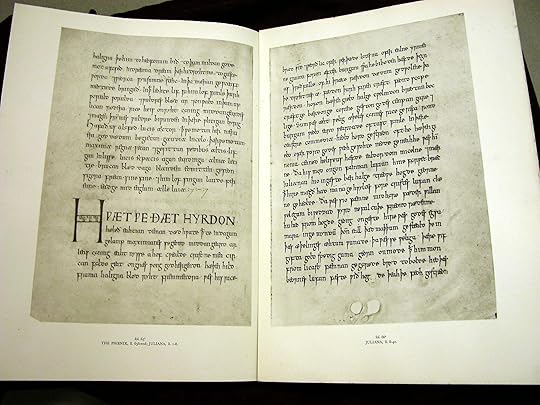
The Exeter Book of Riddles
The Exeter Book, also known as the Codex Exoniensis, is a tenth-century anthology of Anglo-Saxon poetry. The book was donated to the library of Exeter Cathedral by Leofric, the first bishop of Exeter, in 1072. Of the 131 pages that it consisted off, 8 are lost. Despite this, the Exeter Book is the largest known collection of Old English Riddles still in existence.
The Anglo-Saxons loved poems and Riddles. It was certainly one way to pass the long dark nights. In particular they seemed to enjoy rather naughty riddles which had two meanings – a real one and a much more fun rude one. Naturally the idea was to work out the real meaning with out making the mistake of falling for the obvious one. Here are some examples. The answers are at the bottom of the page.
The numbers here are the numbers generally associated with the riddles
74.
I’m a wonderful thing, a joy to women,
I’m a wonderful thing, a joy to women,
to neighbors useful. I injure no one
who lives in a village save only my slayer.
I stand up high and steep over the bed;
underneath I’m shaggy. Sometimes ventures
a young and handsome peasant’s daughter,
a maiden proud, to lay hold on me.
She seizes me, red, plunders my head,
fixes on me fast, feels straightway
what meeting me means when she thus approaches,
a curly-haired woman. Wet is that eye.
The clue is in the lines I injure no one …. save only my slayer and Wet is that eye. Any ideas?
75.
Splendidly it hangs by a man’s thigh,
under the master’s cloak. In front is a hole.
It is stiff and hard; it has a goodly place.
When the young man his own garment
lifts over his knee, he wishes to visit
with the head of what hangs the familiar hole
he had often filled with its equal length.
Something specifically designed to fit just one hole.Check the answers at the bottom.
76.
I have heard of something wax in a corner,
swell and pop, lift up the covers.
A proud-minded woman seized with her hands
that boneless thing, a prince’s daughter;
covered with her dress the swelling thing.
Think cooking.
77.
A youth came along to where he knew
she stood in a corner. Forth he strode,
a vigorous young man, lifted up her own
dress with his hands, thrust under her girdle
something stiff as she stood there;
worked his will; both of them shook.
A thane hurried up, useful at times,
a capable servant; nonetheless he grew tired
from time to time, though strong at first,
weary with work. Beneath the girdle
there began to grow what often good men
love heartily and buy with money.
A piece of equipment used to make commonly consumed produce.
The language in these riddles is sometimes clumsy in translation. As with all puns and riddles they often work best in the original language. But often they give us a hint of a clever use of language that indicates that despite living in what we call the Dark Ages these monks and scribes had both a well developed sense of humour but also knowledge of irony and pun. Ok then what about those answers?
74. Onion 75. A key 76. Bread dough 77 Butter Churn.
There are more of these riddles – I may return to the subject.
December 19, 2013
The Darkest Years of the Dark Ages: what do we really know?
When I set out to research books set in the early Anglo-Saxon period I was immediately faced with an enormous problem: finding out what had happened.
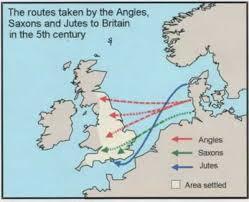
When the last Roman soldier departed Britain in the early 5th century reliable documentation of events started to collapse. The invading Anglo-Saxon tribes were effectively illiterate and it was not until the coming of Christianity (which did not fully pervade England until the late 7th century) that some form of regular record keeping returned. In fact it really took until the time of Alfred the Great at the end of the 9th century for reliable continuous commentaries on the goings on in the land to be kept in the form of the Anglo Saxon Chronicle and other documents.
What then do we do when we want to find out what happened in the early Saxon period? Where could I turn to when writing a book set in the late 6th century?
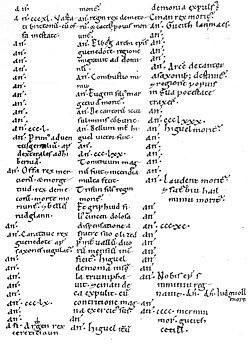
The documents that I turned to when trying to found out what historians knew about this period were:
De Excidio et Conquestu Britanniae On the Ruin and Conquest of Britain by Gildas. Gildas was a monk who lived around AD 500 to 570 in the Dumfries area of Scotland (what was then the British Kingdom of Strathclyde). Much of what we know about the possible existence of Arthur, Vortigern, Ambrosius and so on comes from Gildas. His writing shows the state of chaos and confusion with a land split between half a dozen races and the civilization that had persisted for four centuries collapsing. There are limits to Gildas however. Firstly he had a message to pass on. He wrote about the downfall of Britain – the end of Roman rule and the invasion of the Anglo Saxons and very much argued that this was God’s punishment for their sins. More importantly he died around AD 570 – JUST before the period I was writing about.
The Historia ecclesiastica gentis Anglorum: Ecclesiastical History of the English People by Bede. Bede was a late 7th and early 8th century scholar and monk. His main work is believed to have been completed in 731. Bede writes a lot about the ancient (to him) history of Britain and basically stopped around the fall of Britain and the end of Roman rule, picking up the story with the Augustine mission in 597. He only really gets interested in the conflict between Celtic and Roman Christianity and the conversion of kings and very much argues that the defeat of the Britons is the result of them backing the wrong horse (theologically speaking). So he was quite content to report Pagan English slaughter of Welsh monks as being justified for example. All that said he has a lot of detail from the early 7th century onwards BUT there is an agonising gap before about AD 600.
The Historia Brittonum, or The History of the Britons, is a historical work that was first composed around 830 by the Welsh Monk Nennius. It contains a lot of of detail on the Arthurian period and some full genealogies of the Royal Families of Deira and Bernicia but again there is an annoying lack of commentary on the late 6th century.
Annales Cambriae, or The Annals of Wales, and other Annales in Ireland and Scotland are chronologies and lists of dates compiled in the 8th to 12th centuries in various monasteries and then combined together. They offer snippets and brief glimpses of events – particularly brief the further back you go. Names come up, some useful dates but very little detail. It its like looking at the contents page of history text book! Scholars though can study all these fragments and combine them into something approaching a coherent history and these add some knowledge.

The Anglo Saxon Chronicle (late 9th century and afterwards)
Probably started by King Alfred the Great who at least sponsored and encouraged it, this was a chronicle of events in England and surrounding lands recorded by monks. It focuses on the large events, battles, Kings and Lords and so forth and at first glance would seem to be just the thing. BUT there are limitations to its usefullness. The writers were living in a period over three hundred years after the events they recorded and so were relying on passed on word of mouth or old documents that no longer exist and we cannot validate. Moreover the Chronicle is south centric – focusing for the most part on the events in the southern kingdoms and little on those in Northumbria where my story is set. This is so much so that the chroniclers seems to just simplify matters by lumping the Royal Houses of Deira and Bernician (the two parts of Northumbria) into one. Fortunately other geneaologies do exisit for this period. The historic Battle of Catreath which did so much to shape the north is not even mentioned in the ASC. Then again it is not mentioned in many places.
Welsh Poetry
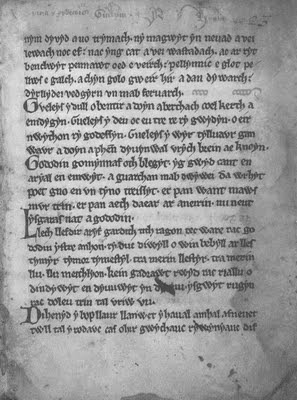
Oddly enough it is poetry, not historical documents, that shed some more light on these dark years. The British poets and bards Aneiren and Taliessen witnessed or heard about the great and traumatic moments of the late 6th century. To them it was real life, happening to them and those they knew. Taliessen lived circa 534 to 599 or early 600′s and wrote about Urien and Owain of Rheged. Much of what we know about the struggles between Bernicia and Rheged we read of in his poems. Aneirin was younger – possible a young man in 597 at the battle of Catreath and it was his poem about it – Y Goddodin that is really the only record of the event.
Modern References
There are many books that have been written that discuss events in he period 550 to 650 AD. It can be tempting to take them at face value and assume they are correct. However you soon discover that they often contradict each other and that many are making assumptions and simplifications themselves and that all struggle with the same paucity of original sources. So all must be taken with a pinch of salt. That said there are a few useful sources for someone researching this period:
The Mammoth Book of British Kings and Queens Mike Ashley takes all the material including a vast number of commentaries and modern books on the monarchies and nations of the last 2000 years and tries to set out a definitive record. It is the most accessible of the reference tools I used.
The Age of Arthur John Morris. Written by an academic whose area of expertise was the period 350 to 650 this tries to lay out as fact a coherent history for the period. It ha been widely criticized by historians for relying heavily on interpretation but at least Morris gives us A version of history. The problem with many academics work is there is almost NO attempt to sift the evidence and present an interpretation. Morris has the courage to do that.
An English Empire NJ Higham is a work that conducts an analysis of what Bede writing tells us about this period and is a useful commentary although a bit limited to Bede’s perspective.
The Britons Christopher Snyder is an academic work with a lot of archaeological references but is a good summary of current thinking on the period. He presents the arguments that are current (or where a few years ago) and tries to weigh them.
Making sense of it all
This then is the problem that writers of historical fiction set in the late 6th and early 7th century have. There is something like a 150 year gap in reliable data. There are theories and ideas but in the end you just have to examine it all, visit the possible battlefields and locations that are known about and make the best effort to create a believable world, to bring to life those that lived in these forgotten but critical years – the birth of England.
—————————-
I write Historical Fiction set in the late 6th and early 7th Century. The Amber Treasure is the BRAG Medallion winning first book in the Northern Crown Series for older teens and adults. Shield Maiden in the Children’s Literary Classics Silver Medal winning first book in the Nine World Series for children. Both are currently free in e-book form. on Apple, Kobo, Barnes and Noble, Smashwords and (some of the time) on Amazon.
Giveaways: Two copies of The Amber Treasure paperback can be won. Email me via http://www.richarddenning.co.uk/contact.html and I will draw names and post out the 2 copies to the winners. The prize will be declared on 1st January.
Do join the Blog Hop and visit these other interesting authors!
Helen Hollick : A little light relief concerning those dark reviews! Plus a Giveaway Prize
Debra Brown : The use of Light on Book Cover Art
Prue Batten : Casting Light….Plus a Giveaway Prize!
Alison Morton Shedding light on the Roman dusk Plus a Giveaway Prize!
Anna Belfrage Let there be light!
Beth Elliott : Steering by the Stars. Stratford Canning in Constantinople, 1810/12
Melanie Spiller : Lux Aeterna, the chant of eternal light
Janet Reedman The Winter Solstice Monuments
Petrea Burchard : Darkness – how did people of the past cope with the dark?
Richard Denning : The Darkest Years of the Dark Ages: what do we really know? Plus a Giveaway Prize!
Pauline Barclay : Shedding Light on a Traditional Pie
David Ebsworth : Propaganda in the Spanish Civil War
David Pilling : Greek Fire Plus a Giveaway Prize
: Fear of the Dark
Derek Birks : Lies, Damned Lies and … Chronicles
Mark Patton : Casting Light on Saturnalia
Tim Hodkinson : Soltice@Newgrange
Wendy Percival : Ancestors in the Spotlight
Judy Ridgley : Santa and his elves Plus a Giveaway Prize
Suzanne McLeod : The Dark of the Moon
Katherine Bone : Admiral Nelson, A Light in Dark Times
Christina Courtenay : The Darkest Night of the Year
Edward James : The secret life of Christopher Columbus; Which Way to Paradise?
Janis Pegrum Smith : Into The Light – A Short Story
Julian Stockwin : Ghost Ships – Plus a Giveaway Present
Manda Scott : Dark into Light – Mithras, and the older gods
Pat Bracewell Anglo-Saxon Art: Splendor in the Dark
Lucienne Boyce : We will have a fire – 18th Century protests against enclosure
Nicole Evelina What Lurks Beneath Glastonbury Abbey?
Sky Purington : How the Celts Cast Light on Current American Christmas Traditions
Stuart MacAllister (Sir Read A Lot) : The Darkness of Depression

December 1, 2013
Power of Free: Giving away books
 As an author I have had to sweat and toil to produce my books. Having put all of that effort in over several years it the idea of giving away free books is understandably abhorrent to many authors. Yet as a self published author the greatest difficulty is not even writing the book, getting it edited and published : its getting it noticed. I had read of a number of authors who had significant success in giving away the first book in a series. The theory here is that if you get enough readers to download your first book then many will return wanting more.
As an author I have had to sweat and toil to produce my books. Having put all of that effort in over several years it the idea of giving away free books is understandably abhorrent to many authors. Yet as a self published author the greatest difficulty is not even writing the book, getting it edited and published : its getting it noticed. I had read of a number of authors who had significant success in giving away the first book in a series. The theory here is that if you get enough readers to download your first book then many will return wanting more.
Currently I have the first book in three of my series available for free. I am monitoring results.
Do people download free book?
The answer is a definite yes. The following table reveals the free downloads of these books from August to November on 3 Channels:
Google e-books; Smashwords which includes Apple, Kobo, Barnes and Noble and Sony amongst others and finally Kindle.
The Amber Treasure
Tomorrow’s Guardian
Shield Maiden
Total
Google e-books
155
163
27
Smashwords
300
24
11
KIndle
1243
1100
0
Total
1698
1287
38
3023
So this approach of giving away books for free is a good way to at least get folk downloading your books. This often results in the books shooting up the free charts on kindle:
Does it increase sales of sequels?
I am a self published author of 7 books which between them have sold approaching 1600 copies. So my monthly sales figures are not huge. However I have sen an increase in the sales of the sequels of The Amber Treasure and Tomorrow’s guardian in the last 2 months. The blue bars here is sales in the UK for Child of Loki the sequel to The Amber Treasure.
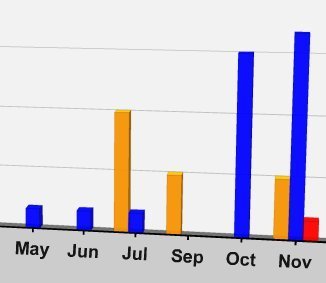 How do you give away books for free?
How do you give away books for free?
Giving a way e-books is very easy with Google E-books and Smashwords. In both cases you can directly control the price and set them to free. Apple in particular likes free books and have been known to do special promotions of free books. When you set prices free on Smashwords that controls the prices on Kobo. Sony, Apple and Barnes and Noble.
Now Kindle is different. Amazon will only allow you to set book at free if you enroll in Kindle Select and give Kindle exclusive rights to your book. That means you can’t sell the book via Google or Smash-words or anywhere else. In addition via Kindle select you can only have the book free for a limited time of a few days.
The Trick:
The trick to getting Kindle to set your books at Free is to set it free on all other platforms. Amazon does not like being more expensive than other alternatives and once they spot the book is free elsewhere they often set the book to free for extended periods of time.
Free Promotions
There are a number of sites that will promote free books via social media so be sure to let them know so they can tell every one about your book.

November 15, 2013
What do we know of Vanaheim?
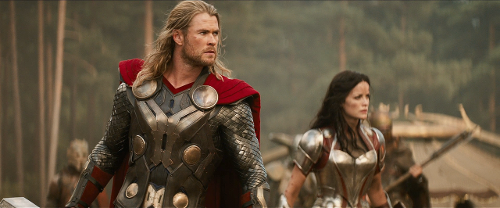
Anyone who has seen the Thor 2 movie will have seen a short scene set on the world of Vanaheim. That movie does not reveal much of the nature of that world beyond it being a forested world. The next in my Nine Worlds series is set mainly on this world so I thought I would explore what we know from mythology of this world.
In Anglo-Saxon and Norse mythology Vanaheim is mentioned as one of the Nine Worlds. However, not as much is known about it as with other worlds, such as Asgard. What then can we say about it? What did the Anglo-Saxons believe about this world and its inhabitants?
Vanaheim is the home world of the Vanir gods. These gods were considered a distinctly different race to the Æsir gods of Asgard. They are often associated with having power over the weather, fertility and crops and the harvest. Their world is described as having gentle winds and refreshing rain. So a green world with forests seems right. The Vanir are also thought to have more wisdom than the Æsir and possibly to have discovered the powers of magic before the Æsir did. They are also supposed to have had the ability to see into the future.

The Æsir-Vanir War
Not all the Vanir were good natured. One of them was a witch called Gullweig who travelled to Asgard to try to get gold from the Æsir by trickery. When the Æsir discovered her they killed her. The Vanir did not like this and a great war occurred – the first war in prehistory. Both sides were gods and so were powerful and the war raged on without conclusion. Eventually the Vanir actually breached the defences of Asgard, but could not defeat Woden’s forces. The stories tell of great damage and harm to both Asgard and Vanaheim’s armies. In the end, however, peace was made. To guarantee the peace hostages were exchanged. Two Asgardians went to Vanaheim whilst three Vanir gods went to Asgard.
Who were the Vanir?
We do not know as many names of the Vanir as we do of the Æsir. Most of the stories and legends are of the Æsir gods. But we do know a few. Firstly these included the three gods who went to Asgard at the end of the war – the god Njord and his son Frey and daughter Freya.
Njord was the god of winds at sea and would fill the sails of ship. He would also blow out wild fires in forests if he saw them. Freya was the same Goddess Freya who was mentioned in Shield Maiden, and who possessed the Brinsingammen and the Falcon Cloak. Her brother Frey was a god of fertility, which means that he helped plants and animals to grow and have young. His symbol was a boar after his own magical boar on which he rode through the heavens in midsummer, encouraging the sun to shine longer, and he helped the crops to grow by mixing sunlight and rain. When the Anglo-Saxons held feasts and ceremonies in his honour they would cook boar. Frey owned a sword called Gambantein. (See About Gambantein below.)
These three had left Vanaheim and lived in Asgard. Do we know any names of the other Vanir? Kvasir was a Vanir god known for his great wisdom but he was killed. (See About the Mead below).
Ullr appears to have been a Vanir god and also a warrior god, perhaps also a god of hunting. In fact he was worshipped quite early in our history, possibly dating back to prehistory. There are early references to him in inscriptions and jewellery. He is depicted as having a bow and arrow. He also is often shown as wearing skis – presumably to travel round the snow-covered Scandinavian landscape. He is still a patron saint of winter sports in Northern Europe. He only appears in the earliest Norse sagas and vanishes from the later stories.
In fact the entire Vanir race was mostly ignored by the later sagas and this might mean that the Vanir were worshiped by one group of Germanic-Scandinavian tribes and the Æsir by another. The latter group were perhaps more powerful and although the myths include them both, more attention is given to the Æsir.
About the Mead
As has already been mentioned, the Vanir were able to see the future. This was actually accomplished by making a special form of mead. Mead is similar to beer or cider, but is made from honey and is a sweet-smelling and tasting alcohol.in Anglo-Saxon times, mead, like beer, would have been drunk by children as well as adults, but batches produced for common drinking were much less alcoholic. The story goes that the Vanir had a special recipe that gave them the power of foretelling. This was made from honey, but also the blood of a wise Vanir god called Kvasir, who was killed by evil dwarves – or possibly dark elves. The mead is mentioned a number of times in the Norse legends and often is referred to as the “Mead of Poetry”.
About Gambantein
Gambantein is a powerful sword. The gods possessed a number of powerful swords and Gambantein belonged to the Vanir God, Frey. It was said to be able to float and fight by itself and so was presumably intelligent. It could shine like the sun and maybe burst into flames. Magical runes added to it enabled it to suck life out of a foe or age them. The legends do indeed say that Frey gave it away to his servant as a reward for the servant arranging a marriage between him and Gerdr, the giantess. The servant actually threatened Gerdr with the sword to get her to agree! When she first met Frey she fell in love with him anyway, so perhaps Frey would have been better just talking to her in the first place!
The Falcon Cloak
Freya owned a suit or cloak made of Falcon feathers, which was capable of transforming the wearer into a falcon. She could use it to fly around the Nine Worlds.
The Nine Worlds series are historical fantasy novels for Middle Grade children and above. They blend the historical world of Anglo-Saxon Britain with the myths and legends our ancestors believed in. This is the world if the stories were true. http://www.richarddenning.co.uk/shieldmaiden.php

October 21, 2013
England Expects
21st October 1805 was the Battle of Trafalgar. Nelsons 33 ships shatter a superior number (41) French and Spanish, save Britain from Invasion and change the course of history.
Why did Trafalgar Happen?
The British Navy has spent the summer chasing the French around the Atlantic. The French had been trying to evade Nelson so they could reach the channel and ferry accross three Corps of troops for an invasion of Britain. Nelson had prevented this and the French admiral Villeneuve had retreated to Cadiz. In October Napoleon ordered him to sail to Naples and land his men there to reinforce the French forces in Italy. On the way Nelson intercepted them off Cape Trafalgar and engaged them.
Nelson changes the game
Historical large fleets of the time would line up and blow each other to pieces. This was a strategy which did not often lead to a results – more an attritional grinding down of the enemy. Furthermore it did not allow for the inferior side to beat the larger fleet.
At Trafalgar Nelson had the smaller fleet. It was, however, better trained and the British gunners could reload faster and maintain a higher rate of fire. The Spanish in particular tended to rely on larger number of marines who would attempt to storm enemy ships. They also often had larger vessels with more guns than Britain’s more maneuverable line ships. What Nelson did was to change the rules of the game. Rather than lining up and sailing alongside the enemy he sailed AT them from their flank. He arranged his ships in two divisions – Nelson in the Victory leading one division with Admirals Collingwood the second. They sailed towards the enemy aiming to cut the enemy line in two places. Since that would mean a larger part of the enemy fleet would have to turn and sail back AGAINST the wind he hoped to over whelm the rest before fighting the leading elements.
As the British fleet closed in, just before the firing started , Nelson stood on the HMS Victory – his flagship – and sent his famous signal to the fleet:
“England expects that every man will do his duty”.
He then signaled for close action. The Navy was to sail in as close as possible, hold fire until the last moment and then release hell.
This is exactly what occurred. The British navy used local superiority in numbers and superior fire power to sink or capture the bulk of the enemy fleet before the rest could turn and help. Over 20 enemy ships were captured- a blow from which the French and Spanish never recovered. the British did not lose a single ship, the French lose 10 and the Spanish 11. IN total whilst the British lost about 1600 men dead and wounded, the enemy had suffered 13,000 casualties.
Tragically at the height of the battle a French sniper shot Nelson. The architect of this great victory died below decks knowing he had won.
The day after Trafalgar there was a huge storm where ironically many of the ships the British had captured sank.
A historical day
Trafalgar was a pivotal day. It was a huge part of the establishment of Britain’s Navy as supreme world wide (a supremacy that last over 140 years until WW2 saw the build up of the Huge US fleets).

October 6, 2013
Just how dirty were the Anglo-Saxons?
We tend to think that the majority of the people that came before us were dirty and smelly – maybe with the exception of the Romans and their bath houses. Was this true of the Anglo-Saxons? What evidence is there of their bathroom habits?
One item which has been found in many burial sites from the pagan era (roughly 5th to 8th centuries) are sets of usually bronze or sometimes bone consisting of usually 3 items. There were tweezers for cutting nails or removing unwanted hairs, little spoons for scooping wax from your ears and picks for removing dirt from behind the finger nails.
So they seemed to bother about their nails. They also took care of their hair. Many combs have been found in graves and these are usually made from bone, antler or horn.
What about bathing and washing? Well it seems that the Saxons were not regular practitioners of whole body immersion. Even so they would bath a few times a year and particularly when they got married. They would also use baths as a medicinal method. This is shown by recipies in Bald’ Leechbook (a collection of Anglo-Saxon cures), For example Oakbark used in baths to ease aching thighs. he also refers to the herb Lion’s foot, baths of which can help a “bewitched” patient.
Whilst whole body bathing was less commonly done, washing of the hands and feet though was done daily and usually they would wash hands before a meal. Indeed the washing of hands at the start of a feast was it seems part of the ceremony. The Sutton Hoo burial included a fine bowl which would have been suspended from chains an in which all guests would be invited to wash their hands before eating – a sensible precaution given the fact that you were often eating with by your hands and taking food from common bowls and plates.
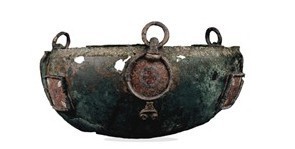 Even though the Anglo-Saxons might not bathe that often they were very familiar with a huge range of plants and herbs – like Rosemary and Lavender which have strong aromas and could be used when washing one’s hair, clothes or hands or just around the house to fragrance it.
Even though the Anglo-Saxons might not bathe that often they were very familiar with a huge range of plants and herbs – like Rosemary and Lavender which have strong aromas and could be used when washing one’s hair, clothes or hands or just around the house to fragrance it.
So in conclusion they may not have been as clean and well groomed as modern tastes may prefer but I am sure that they would not have stunk to the extent that we might expect.



